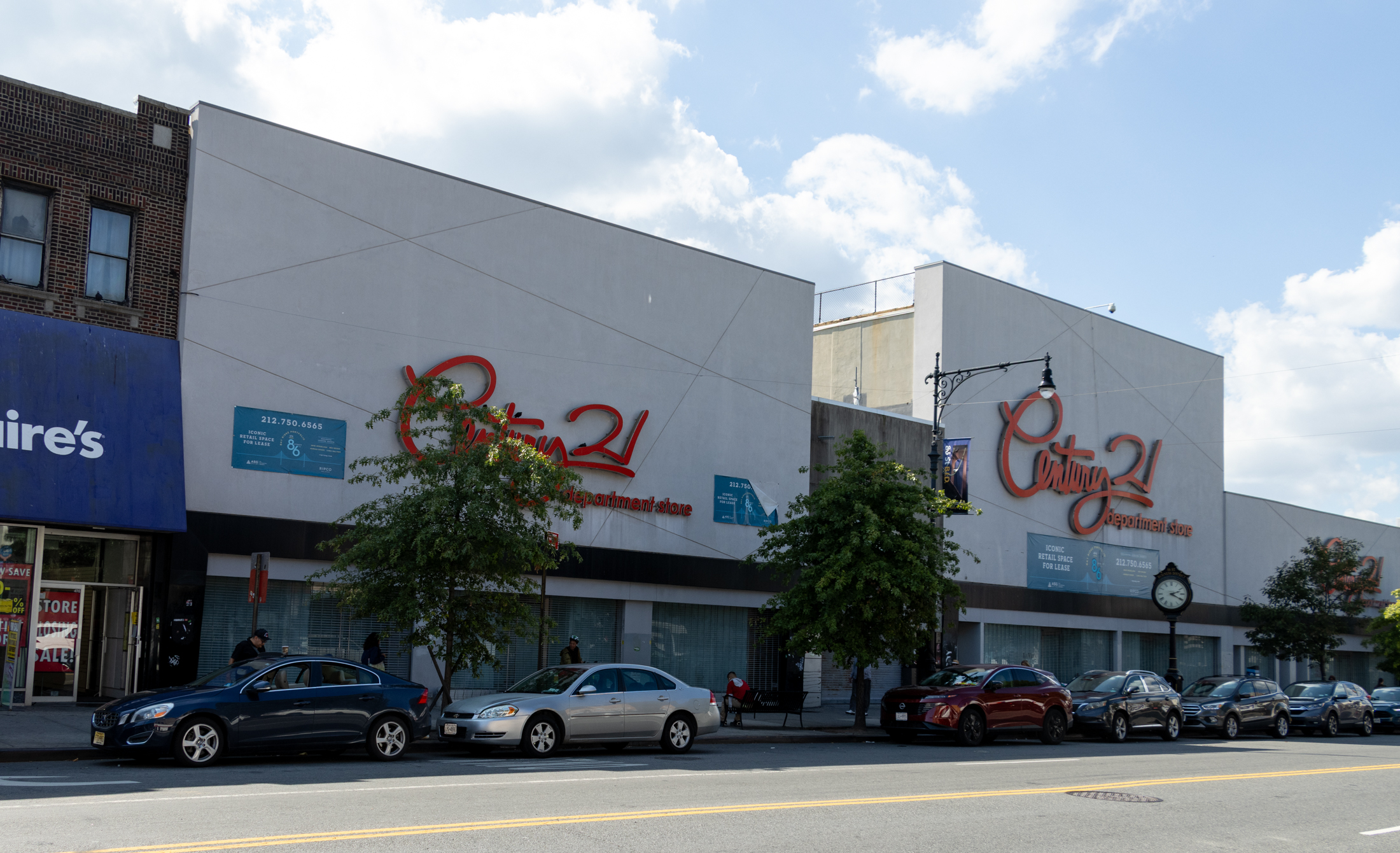Nets Coming Late to Atlantic Yards and Suit Coming Soon
Two new developments in the Atlantic Yards saga. Atlantic Yards Report reveals that the Nets have three more years at the Meadowlands’ Izod Center, not two, meaning the 2010 opening date Bruce Ratner has been promoting may be nothing more than a pipe dream; we might be looking at 2012 for the team’s debut. Besides…


Two new developments in the Atlantic Yards saga. Atlantic Yards Report reveals that the Nets have three more years at the Meadowlands’ Izod Center, not two, meaning the 2010 opening date Bruce Ratner has been promoting may be nothing more than a pipe dream; we might be looking at 2012 for the team’s debut. Besides the team’s schedule, there’s the issue of construction. Ratner tells some outlets that groundbreaking won’t begin until January; to others, he says November.
As construction remains stalled at the site, a lawsuit goes forward. Nine property owners and tenants filed a petition against the Empire State Development Corporation in the Appellate Division Second Department of New York State Supreme Court. They’ve got five beefs: The seizure of their property violates the public use clause contained in the Bill of Rights of the New York Constitution; violates the due process clause contained in the Bill of Rights of the New York Constitution; violates the equal protection clause contained in the Bill of Rights of the New York Constitution; violates the low-income and current resident requirements of the New York Constitution; and violates the “public use, benefit or purpose” requirement contained in New York’s Eminent Domain Procedure Law (EDPL). They expect to hear the case in January of 09, apparently long before a single building will rise on the site. Check out the press release below.
AY Arena Might Open 2011 [AY Report]
Goldstein et al. v. Empire State Development Corporation [DDDB]
Appeal Over Atlantic Yards Suit Filed [Brownstoner]
Supreme Court Won’t Hear AY Eminent Domain Case [Brownstoner]
Photo by threecee.
DEVELOP DON’T DESTROY BROOKLYN
For Immediate Release: August 4, 2008
Nine Property Owners and Tenants File Atlantic Yards Eminent Domain Challenge in New York State Court
Petitioners Seek to Prevent New York State’s
Seizure of Their Homes and Businesses by Eminent Domain
BROOKLYN, NY— Late Friday nine property owners and tenants—with homes and businesses New York State wants to seize for developer Forest City Ratner’s Atlantic Yards project—filed a petition with the Appellate Division of New York State Supreme Court seeking an order rejecting the Empire State Development Corporation’s (ESDC) findings and determination to seize their homes and businesses by eminent domain.
The court argument will likely be in January 2009.
“New York Courts have a proud history of interpreting the New York Constitution as providing greater protections for individual rights than the federal constitution. This case presents an opportunity to continue that tradition by declaring that the New York Constitution prohibits the government from seizing private homes simply to turn them over to a developer who covets them for a massive luxury condominium project,” said lead attorney Matthew Brinckerhoff of Emery Celli Brinckerhoff & Abady LLP. “We are confident that the court will see this for what it is: government officials bending to the will of Bruce Ratner, allowing him to wield the power of eminent domain for his personal financial benefit.”
Facing the seizure of their homes and businesses, the petitioners have alleged five claims against the ESDC— the condemning authority utilized by Forest City Ratner to take the petitioners’ properties and give them to Forest City Ratner. The five claims are that the ESDC’s determination to forcibly seize the properties should be rejected because:
1. It violates the public use clause contained in the Bill of Rights of the New York Constitution.
ESDC’s claims of public benefit are a pretext to justify a private taking.
2. It violates the due process clause contained in the Bill of Rights of the New York Constitution.
The public process was a sham. The outcome was predetermined in a back room deal between Ratner, Pataki and Bloomberg.
3. It violates the equal protection clause contained in the Bill of Rights of the New York Constitution.
By singling out the petitioners, for unequal, adverse, treatment, and selecting Ratner as the recipient of irrational largess, the ESDC violated the petitioners’ right to equal protection under the law.
4. It violates the low-income and current resident requirements of the New York Constitution.
The New York State Constitution provides that no loan or subsidy shall be made to aid any project unless the project contains a plan for the remediation of blight and the “occupancy of any such project shall be restricted to persons of low income as defined by law and preference shall be given to persons who live or shall have lived in such area or areas.”
The Atlantic Yards project is not “restricted to persons of low income” and no preference has been given to “persons who live or shall have lived in such area.”
5. It violates the “public use, benefit or purpose” requirement contained in New York’s Eminent Domain Procedure Law (EDPL).
ESDC’s determination that petitioners’ homes and businesses will serve a “public use, benefit or purpose” has no basis in fact or law.
The petition to the Court for the case, Goldstein et al. v. Empire State Development Corporation, can be downloaded at: www.dddb.net/eminentdomain
————————————————
Develop Don’t Destroy Brooklyn—in its effort to defend the homes and businesses of community members and advocate for their rights—organized the eminent domain lawsuit, and raises the funds for the lawsuit.
————————————————
DEVELOP DON’T DESTROY BROOKLYN leads a broad-based community coalition
fighting for development that will unite our communities instead of dividing and destroying them
DDDB is 501c3 non-profit corporation supported by over 4,000 individual donors from the community.
###





Is anyone bothered that the stadium is being funded almost ENTIRELY by our tax dollars and naming rights?
Never said that Biff- my point was, and I just found several great reports of the impact of cities on the environment which make the point- density is well and good, and public transportation is important in reducing environmental impact, but it’s only part of the whole problem and Newman’s Environmental Impact of Cities (I’ll send it to you later if you want) makes the point at how crucial they can be to reducing on impact on the environment and more efficient use of resources but also says that in order to accomplish that, other things have to be done to mitigate the effect large, densely populated cities have on their inhabitants and the surrounding areas.
One of the reports says that in poor or developing countries, large, densely populated cities actually have very little environmental impact because they actually use and reuse resources and recycle so much. Cities in richer countries have a greater impact because they are more wasteful. It also takes city governments to task for poor development policies.
So essentially we aren’t disagreeing on the ultimate goal of greater density, we just aren’t seeing eye to eye on if overly dense projects like AY -at this point -help or harm.
I disagree re: suburbs versus cities. The sprawl of the suburbs and associated reliance on cars and gas has done significant damage to our environment/carbon footprint. The historical infamous smog above LA is due to the drivers heading in and out of the center of the city, not due to the city dwellers themselves. I’ll read the panel discussion if you agree to watch The End of Suburbia and Who Killed the Electric Car :-). Ok, I’ll read it now.
As for public transportation, yes, it’s in a poor shape I think in large part because of the mindset and obsession Americans have with respect to their rights and preferences to drive everywhere. And also because the MTA is horrible at running public transportation. But just because the MTA may have neglected the upkeep of their subways and stations doesn’t mean public transportation cannot work effectively and efficiently. We should also force our officials to push for more walking malls, bicycle lanes, etc.
Anyway, back to Atlantic Yards…sorry for the digression.
cmu wrote:
“The stadium by itself is not the “out-of-scale”-ness that the opponents point to, it’s the 4 (or 6?) huge towers.”
The arena is about 15 stories. the other 16, not 4 or 6, towers range (as per the proposal) from about 20 to 55 stories.
fsrg wrote:
“The Unity Plan calls for 1500 units of housing which is is FIVE THOUSAND (5000) less units than Atlantic Yards as currently designed.”
The UNITY Plan proposes development over the 8-acre rail yards. Ratner proposes the 6,400 units over 22-acres. So you can see, they are both high density proposals, considering FAR. Admittedly, Ratner’s is extreme density like never before seen in the United States, while the UNITY plan is a reasonable density.
of course it’s all a nice academic exercise as AY won’t be built (the WHAT is right on that one, though his delivery would have you lose the point) as proposed.
I agree it has been detrimental. But no more so than intensely populated cities, I think. And I do agree public transportation is something we’ve sadly neglected (I don’t own a car so I can attest to this first hand!). I think the point I was trying to make is that by overbuilding and packing density now, without being able to address the impact through technological innovation or improved services, we’ll simply be running in place or losing ground. If transit is already strained, and in need of repair, how does adding that many more people to a hub fix this? Atlantic Ave. is only one stop on a system that doesn’t meet the city’s needs now.
Did you read the panel discussion? I posted the link at 2:14. One of the people on the panel talks about transit hubs and development.
What—you are the smugest jackass on this site. How comical for you to accuse others of this. Noone refutes your points anymore because you don’t allow yourself to be argued with. This in turn causes each entry you make to a thread be a black hole of meaningless vitriol.
Bxgrl:
China is a brilliant example of how high density housing can completely change a society. Literally millions of people in China have modern, cost efficient housing when 20 years ago they had none. Shanghai alone has more high rise buildings than NYC and they were all constructed since 1990.
While China does have environmental issues, they have an exceptionally low carbon footprint similar to many African nations where there is no industry and the people are too poor to buy cars.
http://upload.wikimedia.org/wikipedia/commons/e/ea/GHG_per_capita_2000.svg
bxgrl, I really think the trend of expansion outward is done for now and there’s already a movement inward. People are already returning to/remaining in the cities, thus the boom in demand for family sized apartments; including families opting to move to Brooklyn over the previously preferred areas in Jersey, Connecticut, Westchester, etc.
I don’t think it’s speculation to state that it’s more environmentally friendly and efficient to have more people take public transportation (versus driving an hour or two each way to their jobs), consume less oil/gas/water in condos and coops versus larger suburban homes, etc.
City people like meat more than suburban folks? Maybe that’s true, but I can’t remember the last time I had a barbecue, although I can guarantee 99% of the suburbanites I know have had at least one in the last month (and many likely used charcoal, gasp).
As for pollution, of course cities are going to have to figure out how to deal with and reduce that, but it seems to me they’ve already made progress. The haze above New York actually seems less prominent than it did 10 years ago. I’m not an urban planner, but agreed they will have to resolve many of the logistics with respect to increased garbage, etc. At the end of the day, overall I still believe the suburbanization of America has been extremely detrimental to the environment and we would have been much better off finding ways to encourage people to remain in the cities.
Biff- We don’t really know what will happen until we see more of how new energy technology impacts us. The city is not stagnating at its boundaries. It’s expanding outward and eventually will encompass what are surburban areas now- that’s a process that began the day the Dutch set foot on Manhattan island. I’m not saying there is no correlation between density and maximizing efficiency. It am saying tht while it all looks nice on paper it will take a lot more than speculation to make it work in reality.
If density is the answer to minimizing the environmental impact, what’s that haze in the skyline? Can we talk about the changes in the air quality over densely populated cities and the concentration of toxins, pollution and environmental stressors that build up and go into the atmosphere or spread outward to affect surrounding areas? It’s not just cars that pollute. city people love to eat meat- look at the environmental impact of the beef industry as opposed to agriculture. What about the increased pile up of garbage? Are you going to have facilities to deal with that? Because at some point, the increased density means everything happens more quickly and more intensely and we will simply choke on it if we don’t have a lot of other things in place first.